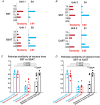State-dependent neural representations of muscle synergies in the spinal cord revealed by optogenetic stimulation
- PMID: 40726105
- PMCID: PMC12369310
- DOI: 10.1113/JP288073
State-dependent neural representations of muscle synergies in the spinal cord revealed by optogenetic stimulation
Abstract
The central nervous system controls movement by combining neuromotor modules, known as muscle synergies. Previous studies suggest that spinal premotor interneurons (PreM-INs) contribute to the encoding of stable muscle synergies for voluntary movement. But descending and sensory inputs also influence motor outputs through the spinal interneuronal network, which may be configured by its inputs to encode different sets of muscle synergies depending on the network state, thereby recruiting different selections of synergies. Here we tested this possibility of state-dependent synergy encoding by examining the muscle synergies represented by the same upstream spinal interneurons under different activity states induced by various optogenetic stimulation patterns. Lumbosacral spinal units and electromyographic (EMG) activities of hindlimb muscles were simultaneously recorded from anaesthetized Thy1-ChR2 mice as the spinal cord was stimulated by one or two optic fibres at different intensities. The synergy encoded by each unit was revealed as a 'muscle field' derived from spike-triggered averages of EMG, whereas the entire muscle synergy set was factorized from the EMG. We found that although the muscle synergy set remained stable across stimulation conditions, the muscle fields of the same units were matched to different synergies within the set in different states. Thus the interneurons may flexibly adjust their connectivity with the motoneurons of the muscles as descending and sensory afferents impose different states on the spinal network. State-dependent encoding of muscle synergies may allow different synergies to be selected for producing stable movement in an ever-changing workspace environment. KEY POINTS: Muscle synergies for locomotion can be represented by spinal interneurons, as revealed by the interneurons' muscle fields derived from spike-triggered averages of EMG. The muscle field of a single spinal interneuron may vary under different stimulation conditions, as demonstrated by optogenetic stimulation. Encoding of muscle synergies is dependent on the state of spinal activities, thus facilitating the selection of appropriate synergies in different dynamic environments.
Keywords: electrophysiology; locomotion; muscle activity; muscle synergies; optogenetic stimulation; spinal cord.
© 2025 The Author(s). The Journal of Physiology published by John Wiley & Sons Ltd on behalf of The Physiological Society.
Conflict of interest statement
The authors declare no competing interests.
Figures







Similar articles
-
Prescription of Controlled Substances: Benefits and Risks.2025 Jul 6. In: StatPearls [Internet]. Treasure Island (FL): StatPearls Publishing; 2025 Jan–. 2025 Jul 6. In: StatPearls [Internet]. Treasure Island (FL): StatPearls Publishing; 2025 Jan–. PMID: 30726003 Free Books & Documents.
-
Inhibitory Components in Muscle Synergies Factorized by the Rectified Latent Variable Model From Electromyographic Data.IEEE J Biomed Health Inform. 2025 Feb;29(2):1049-1061. doi: 10.1109/JBHI.2024.3453603. Epub 2025 Feb 10. IEEE J Biomed Health Inform. 2025. PMID: 39383087
-
Short-Term Memory Impairment.2024 Jun 8. In: StatPearls [Internet]. Treasure Island (FL): StatPearls Publishing; 2025 Jan–. 2024 Jun 8. In: StatPearls [Internet]. Treasure Island (FL): StatPearls Publishing; 2025 Jan–. PMID: 31424720 Free Books & Documents.
-
Cost-effectiveness of using prognostic information to select women with breast cancer for adjuvant systemic therapy.Health Technol Assess. 2006 Sep;10(34):iii-iv, ix-xi, 1-204. doi: 10.3310/hta10340. Health Technol Assess. 2006. PMID: 16959170
-
Management of faecal incontinence and constipation in adults with central neurological diseases.Cochrane Database Syst Rev. 2014 Jan 13;2014(1):CD002115. doi: 10.1002/14651858.CD002115.pub5. Cochrane Database Syst Rev. 2014. Update in: Cochrane Database Syst Rev. 2024 Oct 29;10:CD002115. doi: 10.1002/14651858.CD002115.pub6. PMID: 24420006 Free PMC article. Updated.
References
-
- Ashe, J. , & Georgopoulos, A. P. (1994). Movement parameters and neural activity in motor cortex and area 5. Cerebral Cortex, 4(6), 590–600. - PubMed
-
- Baggen, R. J. , van Dieën, J. H. , van Roie, E. , Verschueren, S. M. , Giarmatzis, G. , Delecluse, C. , & Dominici, N. (2020). Age‐related differences in muscle synergy organization during step ascent at different heights and directions. Applied Sciences, 10(6), 1987.
-
- Berger, D. J. , & d'Avella, A. (2023). Persistent changes in motor adaptation strategies after perturbations that require exploration of novel muscle activation patterns. Journal of Neurophysiology, 130(5), 1194–1199. - PubMed
-
- Bizzi, E. , Mussa‐Ivaldi, F. , & Giszter, S. (1991). Computations underlying the execution of movement: A biological perspective. Science, 253(5017), 287–291. - PubMed
MeSH terms
Grants and funding
- R4022-18/Research Grants Council, University Grants Committee
- N_CUHK456/21/Research Grants Council, University Grants Committee
- 14 114 721/Research Grants Council, University Grants Committee
- 14 119 022/Research Grants Council, University Grants Committee
- 2020.095/The Chinese University of Hong Kong, Faculty of Medicine Direct Grants
LinkOut - more resources
Full Text Sources
Miscellaneous
